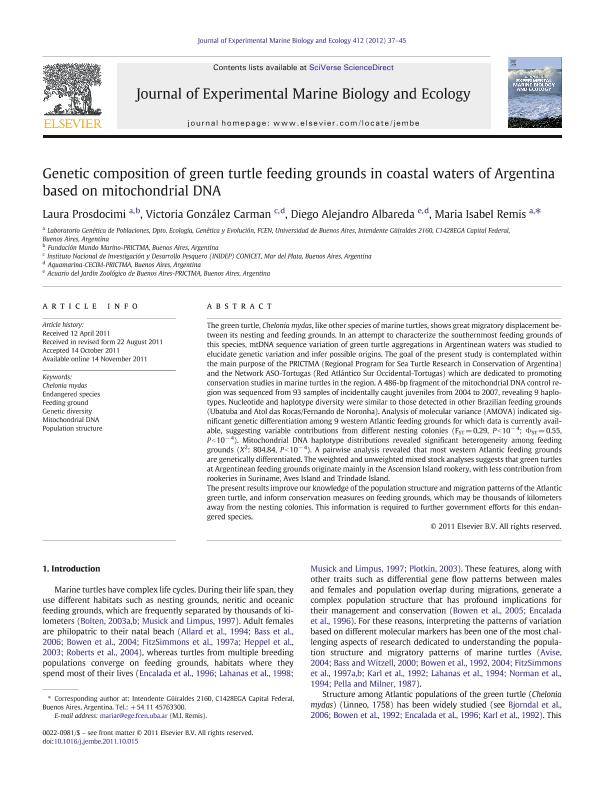Mostrar el registro sencillo del ítem
dc.contributor.author
Prosdocimi, Laura

dc.contributor.author
González Carman, Victoria

dc.contributor.author
Albareda, Diego
dc.contributor.author
Remis, Maria Isabel

dc.date.available
2019-01-25T16:10:16Z
dc.date.issued
2012-01
dc.identifier.citation
Prosdocimi, Laura; González Carman, Victoria; Albareda, Diego; Remis, Maria Isabel; Genetic composition of green turtle feeding grounds in coastal waters of Argentina based on mitochondrial DNA; Elsevier Science; Journal of Experimental Marine Biology and Ecology; 412; 1-2012; 37-45
dc.identifier.issn
0022-0981
dc.identifier.uri
http://hdl.handle.net/11336/68616
dc.description.abstract
The green turtle, Chelonia mydas, like other species of marine turtles, shows great migratory displacement between its nesting and feeding grounds. In an attempt to characterize the southernmost feeding grounds of this species, mtDNA sequence variation of green turtle aggregations in Argentinean waters was studied to elucidate genetic variation and infer possible origins. The goal of the present study is contemplated within the main purpose of the PRICTMA (Regional Program for Sea Turtle Research in Conservation of Argentina) and the Network ASO-Tortugas (Red Atlántico Sur Occidental-Tortugas) which are dedicated to promoting conservation studies in marine turtles in the region. A 486-bp fragment of the mitochondrial DNA control region was sequenced from 93 samples of incidentally caught juveniles from 2004 to 2007, revealing 9 haplotypes. Nucleotide and haplotype diversity were similar to those detected in other Brazilian feeding grounds (Ubatuba and Atol das Rocas/Fernando de Noronha). Analysis of molecular variance (AMOVA) indicated significant genetic differentiation among 9 western Atlantic feeding grounds for which data is currently available, suggesting variable contributions from different nesting colonies (F ST=0.29, P<10 -4; Φ ST=0.55, P<10 -4). Mitochondrial DNA haplotype distributions revealed significant heterogeneity among feeding grounds (X 2: 804.84, P<10 -4). A pairwise analysis revealed that most western Atlantic feeding grounds are genetically differentiated. The weighted and unweighted mixed stock analyses suggests that green turtles at Argentinean feeding grounds originate mainly in the Ascension Island rookery, with less contribution from rookeries in Suriname, Aves Island and Trindade Island.The present results improve our knowledge of the population structure and migration patterns of the Atlantic green turtle, and inform conservation measures on feeding grounds, which may be thousands of kilometers away from the nesting colonies. This information is required to further government efforts for this endangered species.
dc.format
application/pdf
dc.language.iso
eng
dc.publisher
Elsevier Science

dc.rights
info:eu-repo/semantics/openAccess
dc.rights.uri
https://creativecommons.org/licenses/by-nc-nd/2.5/ar/
dc.subject
Chelonia Mydas
dc.subject
Endangered Species
dc.subject
Feeding Ground
dc.subject
Genetic Diversity
dc.subject
Mitochondrial Dna
dc.subject
Population Structure
dc.subject.classification
Otras Ciencias Biológicas

dc.subject.classification
Ciencias Biológicas

dc.subject.classification
CIENCIAS NATURALES Y EXACTAS

dc.title
Genetic composition of green turtle feeding grounds in coastal waters of Argentina based on mitochondrial DNA
dc.type
info:eu-repo/semantics/article
dc.type
info:ar-repo/semantics/artículo
dc.type
info:eu-repo/semantics/publishedVersion
dc.date.updated
2019-01-25T13:38:31Z
dc.journal.volume
412
dc.journal.pagination
37-45
dc.journal.pais
Países Bajos

dc.journal.ciudad
Amsterdam
dc.description.fil
Fil: Prosdocimi, Laura. Universidad de Buenos Aires. Facultad de Ciencias Exactas y Naturales. Departamento de Ecología, Genética y Evolución; Argentina. Fundación Mundo Marino; Argentina
dc.description.fil
Fil: González Carman, Victoria. Consejo Nacional de Investigaciones Científicas y Técnicas. Centro Científico Tecnológico Mar del Plata. Instituto de Investigaciones Marinas y Costeras. Subsede Instituto Nacional de Investigación y Desarrollo Pesquero; Argentina. Aquamarina-CECIM-PRICTMA; Argentina
dc.description.fil
Fil: Albareda, Diego. Aquamarina-CECIM-PRICTMA; Argentina. Ciudad Autónoma de Buenos Aires. Jardín Zoológico; Argentina
dc.description.fil
Fil: Remis, Maria Isabel. Universidad de Buenos Aires. Facultad de Ciencias Exactas y Naturales. Departamento de Ecología, Genética y Evolución; Argentina. Consejo Nacional de Investigaciones Científicas y Técnicas; Argentina
dc.journal.title
Journal of Experimental Marine Biology and Ecology

dc.relation.alternativeid
info:eu-repo/semantics/altIdentifier/doi/http://dx.doi.org/10.1016/j.jembe.2011.10.015
dc.relation.alternativeid
info:eu-repo/semantics/altIdentifier/url/https://www.sciencedirect.com/science/article/pii/S0022098111004606
Archivos asociados
